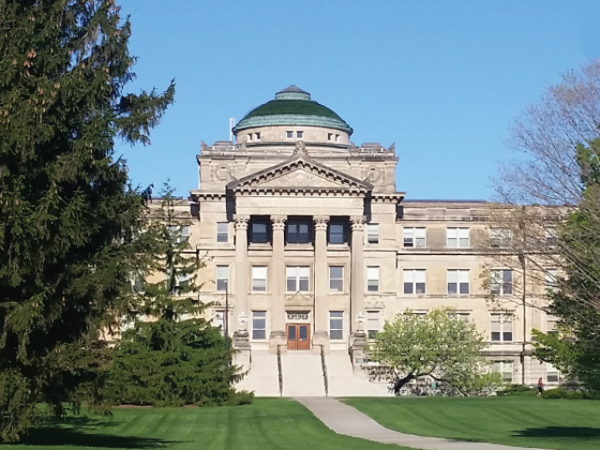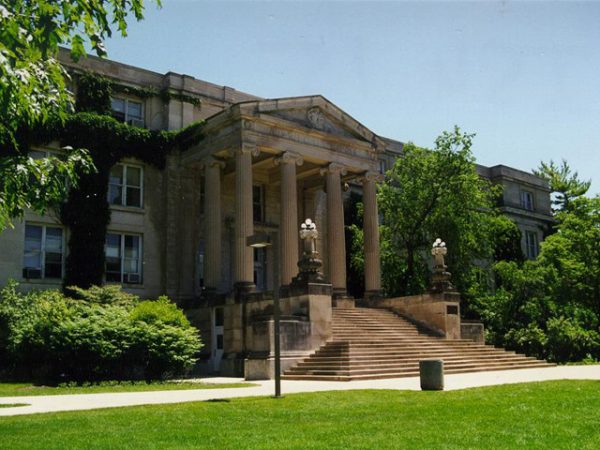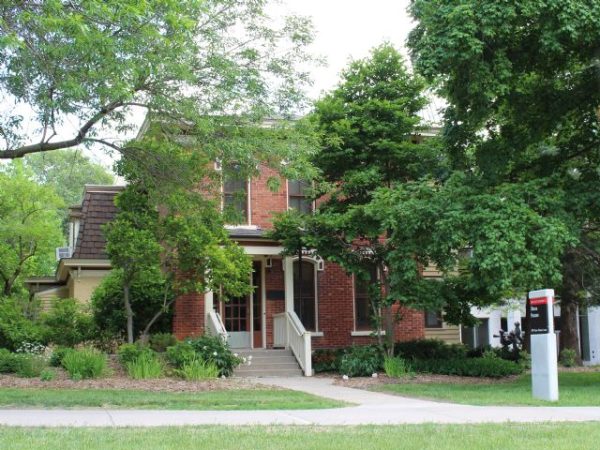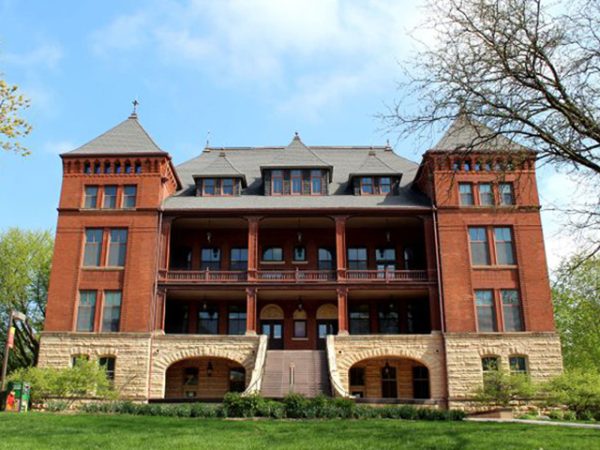By Dianne Bystrom, director emerita, and Jane Cox, professor emeritus
Four buildings on Iowa State University’s central campus – Beardshear Hall, Curtiss Hall, Catt Hall and Sloss House – share histories related to the women’s suffrage movement.
The buildings are named for William M. Beardshear, president of Iowa Agricultural College from 1891-1902; longtime agriculture dean Charles F. Curtiss, who joined the IAC faculty in 1891; women’s suffrage leader Carrie Chapman Catt, who graduated from IAC in 1880; and Thomas Sloss, whose daughter Margaret Wragg Sloss was the first woman to gain admission to and graduate from the ISU College of Veterinary Medicine in 1938.
President Beardshear’s support for women’s suffrage

Beardshear demonstrated his interest in the women’s suffrage movement in 1891, when he sought the support of the Iowa Woman Suffrage Association to secure state funding for a women’s dormitory on campus. According to historian Douglas Biggs, “President Beardshear knew the state had refused to provide funding for a women’s dormitory in the 1880s, and so sought the aid of a powerful constituency” – the Iowa Woman Suffrage Association – which held its annual meeting in Ames in December 1891.1
“Beardshear invited the delegates to campus. The women were impressed with the college, and thought it appropriate to pass a resolution asking the legislature of Iowa ‘to provide for a suitable hall for women’,” Biggs wrote.2
Catt joined the Iowa Woman Suffrage Association in 1887 and, according to newspaper reports, attended and spoke during the group’s Dec. 3-4, 1891, annual meeting in Ames.3, 4 Although there is no evidence that the two ever met, Beardshear and Catt certainly shared a mutual interest in women’s suffrage.
In addition to the Dec. 6, 1891, State Register, the Iowa Woman Suffrage Association meeting was covered in the Dec. 19, 1891, Woman’s Journal, which noted that Beardshear was among the “eminent friends” whose letters were read at the meeting. Letters also were read from such prominent women’s suffrage leaders as Susan B. Anthony, Lucy Stone and Amelia Bloomer.5
Beardshear’s work – including his strategy to enlist the support of the Iowa Woman Suffrage Association – “had the desired effect and state appropriations were committed” for a women’s dormitory at IAC, Biggs noted. “When the women’s dormitory opened in 1895 . . . Margaret Hall added a state-of-the-art dining hall for 800 people in addition to rooms for 88 female students bringing IAC’s total housing capacity to 502.”6
The dormitory was named after Margaret MacDonald Stanton, Iowa State’s first dean of women and the wife of Edgar W. Stanton, head of the mathematics department, secretary to the board of trustees from 1874-1909, and four times acting president. Not only was Iowa State’s first women’s dormitory named for Margaret Stanton, who died in 1895, the first 10 bells of the carillon hanging in the Campanile were presented to the college in her memory.
In addition to Margaret Hall, which was located about where LeBaron Hall now stands, three other buildings were added to the campus during Beardshear’s tenure as president — Morrill Hall (1891); Agricultural Hall (1892), which was renamed Botany Hall in 1928 and Catt Hall in 1992; and the Campanile (1899). In 1938, Iowa State named its central administrative building in honor of Beardshear.
Catt-Curtiss connection

First known as Agriculture Hall, Curtiss Hall — renamed in 1947 for the longtime Iowa State agricultural dean — also shares a connection with Catt, primarily through his wife, Olive, who was active in the women’s suffrage movement. For example, according to the Jan. 2, 1934, Ames Daily Tribune, Olive Curtiss was “in charge” of a program for the local chapter of the League of Women Voters — which Catt founded nationally in 1920 — on the legal status of women in Iowa, “A Married Woman Makes Her Will.”7
Newspapers also document that Catt was often entertained in the Curtiss home, which was in the Farmhouse building on campus. For example, when Catt was on campus in June 1930 to give her second commencement address at her alma mater, some 75 guests — including members of the Pi Beta Phi alumnae club — gathered at the Curtiss home for a tea. Catt was a member of the Pi Beta Phi fraternity as a student at IAC.8
During her June 1930 visit to campus, Catt also attended a lecture presented by Dean Curtiss on “The Agricultural Industry.”9 In the Des Moines Register’s story about Iowa State’s 1930 commencement, Catt was described as the “world famous leader in the women’s suffrage movement.”10
Catt and Sloss friendship

It was during a reception hosted by Olive Curtiss in 1936 — when Catt had returned to the Iowa State campus to open VEISHEA with President Charles Friley — that Catt first met Margaret Sloss, and was immediately impressed with the young woman scientist. On Nov. 4, 1940, Catt wrote Maria Roberts — who began teaching in the mathematics department after graduating from IAC in 1890, later served as dean of the Junior College and for whom Roberts Residence Hall is named — to inquire about the young woman’s name and address. “When I was last at Mrs. Curtiss’ home she had a little reception and among those who came was a pretty sweet young woman who was introduced as a graduate of two or three years before,” Catt wrote. “I asked why she was remaining and, lo, it was because she was a veterinarian!”11
After learning her name, Catt wrote Sloss on Nov. 14, 1940, inviting her to a “prestigious list of one-hundred women who are doing things that no women could have done 25 years ago” that would be recognized at the Woman’s Centennial Congress, 1840-1940.12 Held in New York City, cooperating organizations in the Woman’s Centennial Congress — which Catt chaired — were the American Association of University Women, the National Council of Jewish Women, the National Council of Negro Women and the National Women’s Trade Union League.
Sloss was not able to attend, and wrote Catt on Nov. 21, 1940. In her letter, she thanked Catt for a “thrill of a lifetime” to be recognized by the Women’s Centennial Congress. Sloss also included her concerns about a paper she wrote, “Women in Veterinary Medicine,” which she was having problems getting published as journals, at the time, only accepted articles written by men. “I am sure that it would never be accepted by any of the man-published scientific journals, and probably would lead to a mild furor if it were,” Sloss wrote in her letter to Catt.13
Consequently, Sloss wrote that she planned to “have mimeographed copies made for the other women members of the veterinary profession in the United States.” She added, “If you would be at all interested in my paper, I shall be happy to send you a copy as soon as it is available. In fact, I would very much appreciate having your comments and criticisms on it.”14 Catt wrote Sloss back on Jan. 21, 1941, apologizing for her delayed response, and stating: “I am very much interested in your paper and would be glad to have the privilege of reading it.”15
Catt remained a mentor to Sloss for the next seven years, until her death in 1947. During that time, Sloss progressed through the faculty ranks at the Iowa State College of Veterinary Medicine from instructor (1941) to assistant professor (1943). She was promoted to professor in 1965 and taught until 1972. Sloss died in 1979.
Sloss House, which was built in 1883, is named for Thomas Sloss, superintendent of buildings and grounds at Iowa State, as his family had lived there the longest, from 1925 to 1936. Margaret, the sixth of his eight children, lived in Sloss House as a young woman. In 1981, the Margaret Sloss Center for Women was established in her honor and occupied the first floor of the building, gaining full occupancy of the building in 1985. The center was renamed the Margaret Sloss Center for Women and Gender Equity in 2019.
Shared histories

As we celebrate the 30th anniversary of the renaming of Old Botany to Carrie Chapman Catt Hall and the establishment of the Carrie Chapman Catt Center for Women and Politics — which were both approved by the Iowa Board of Regents in 1992 — it is meaningful to recognize the shared histories of four buildings on Iowa State’s central campus. Beardshear Hall, Curtiss Hall, Sloss House and Catt Hall are connected through the involvement of their namesakes or families in the women’s rights movement from the late 1890s through the 1970s.
Moreover, two of Iowa State’s pioneering women graduates — Carrie Chapman Catt and Margaret Wragg Sloss — share a relationship born in the aftermath of the women’s suffrage movement and the continuation of the fight for women’s rights. Both women were inducted into the Iowa Women’s Hall of Fame — Catt was among the first women honored in 1975 and Sloss was recognized in 2006. Of the hundreds of buildings on the Iowa State campus (excluding residence halls), only four — including Catt Hall — are named solely for women.
Notes
1 Douglas Biggs, “Using Calamity to Drive College Policy: President William Beardshear, Iowa State College, and the Challenge of Enrollment Growth, 1891-1902,” American Educational History Journal 43, no. 1-2 (annual 2016): para. 10.
2 Biggs, “Using Calamity,” para. 10.
3 “Women Who Want to Vote,” State Register, December 6, 1891.
4 “Iowa Annual Meeting,” Woman’s Journal, December 19, 1891, p. 414.
5 “Iowa Annual Meeting,” p. 414.
6 Biggs, “Using Calamity,” para. 10.
7 “League of Women Voters to Meet Thursday,” Ames Daily Tribune, January 2, 1934, p. 7.
8 “Mrs. Knapp is Hostess Wednesday,” Ames Daily Tribune, June 12, 1930, p. 2.
9 “Carrie C. Catt Will Address Senior Class,” Des Moines Register, June 8, 1930, p. 67.
10 “Carrie C. Catt,” p.67.
11 Carrie Chapman Catt letter to Maria Roberts, November 4, 1940, Carrie Chapman Catt Papers, Box 2, Folder 6, Special Collections, Iowa State Library.
12 Carrie Chapman Catt letter to Margaret Sloss, November 14, 1940, Margaret Sloss Papers, Box 1, Folder B, Special Collections, Iowa State Library.
13 Margaret Sloss letter to Carrie Chapman Catt, November 21, 1940, Margaret Sloss Papers, Box 1, Folder B, Special Collections, Iowa State Library.
14 Sloss letter to Catt, November 21, 1940.
15 Carrie Chapman Catt letter to Margaret Sloss, January 21, 1941, Margaret Sloss Papers, Box 2, Folder 3, Special Collections, Iowa State Library.